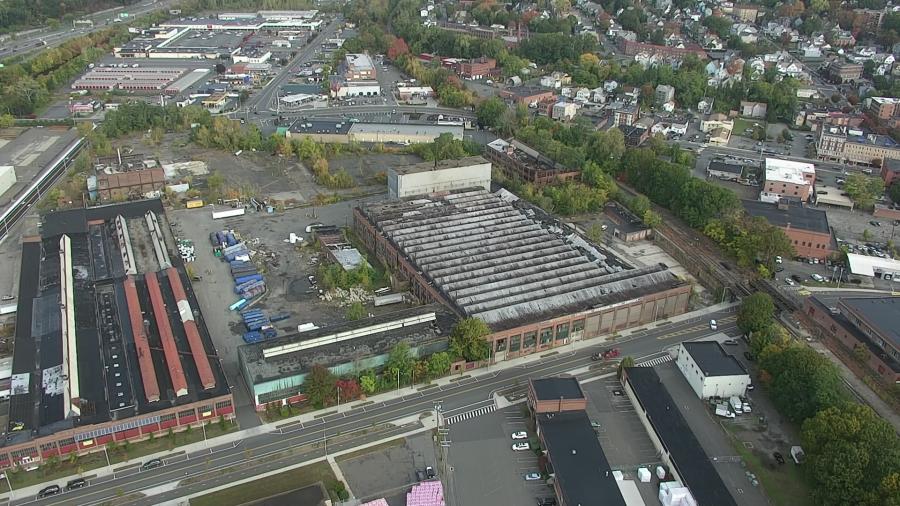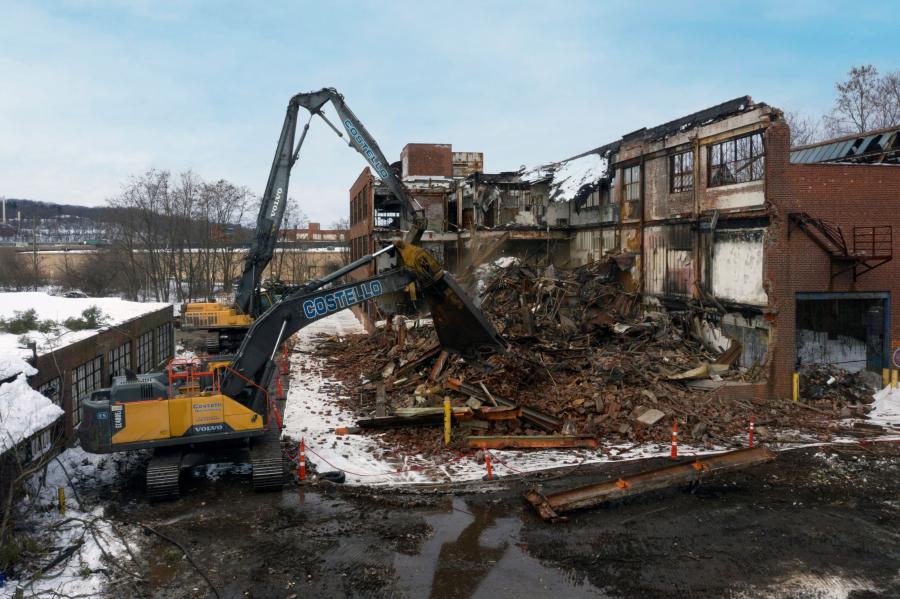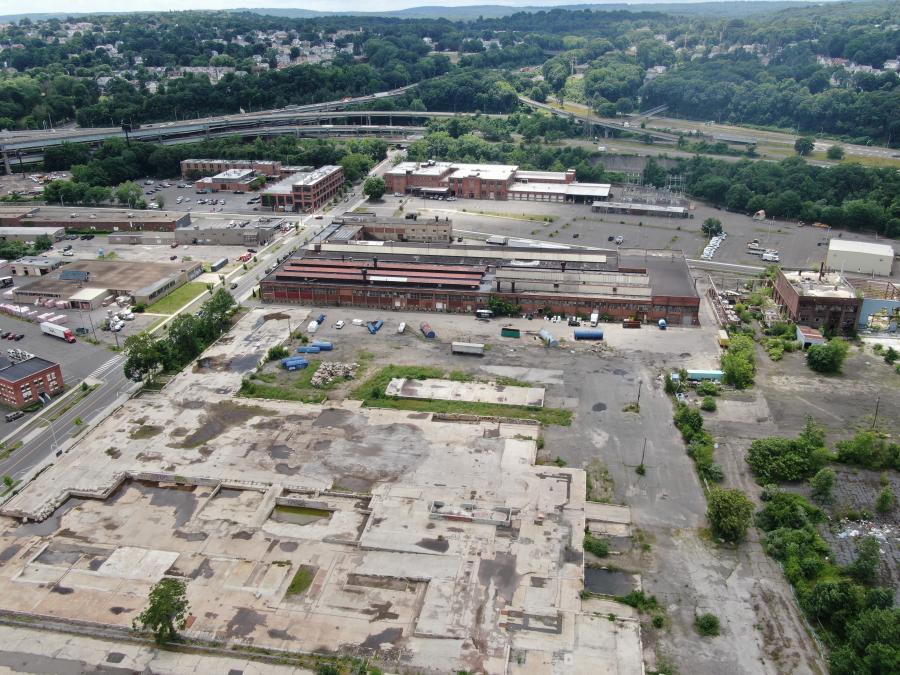Costello Dismantling secured the $2,704,253 demolition and abatement contract in early 2021.
(Photo courtesy of Costello Dismantling Co. Inc.)
Between March and April 2021 and an additional phase in 2022, the Costello Dismantling Company Inc. completed the demolition of the 400,000-sq.-ft. former Anaconda American Brass Company manufacturing plant in the city of Waterbury, Conn. The contractor also removed asbestos and contaminated soil and materials.
The plant — 12 interconnected structures, primarily manufacturing facilities, which closed many years ago — is owned by the city and overseen by the Waterbury Development Corporation. The majority of the buildings were single-story high bay foundry buildings — 40-ft. tall in many areas — and also included a multi-story office space.
Due to widespread contamination and deterioration of the entire complex, more than 10,000 tons of debris was handled and disposed of as PCB and asbestos waste.
Waterbury was known as "The Brass City" because it was home to several brass manufacturing plants.
The plant was located at 130 Freight St. and 000 West Main St. After the company vacated the site, it was utilized as a Connecticut regulated waste treatment and soil remediation facility by Environmental Waste Resources, which ceased operations in 2011.
The 130 Freight St. parcel, 10.56 acres, had eight buildings. The demolition for this portion was covered by a $1.5 million Urban Act State of CT grant. The 000 West Main Street parcel is a 3.28 acres.
Waterbury received $2.2 million — $2 million from the State of DECD and $200,000 from an NVCOG EPA RLF grant — to pay for the demolition, environmental assessment and remediation on both parcels, which are adjacent to each other.
"The two sites were tax delinquent and the city took them over in late 2020," said Tommy Hyde, the WDC's interim director. "The properties had been abandoned for quite some time and had become eyesores for the community. The sites were very contaminated and were subject to the Resource Conversation and Recovery Act. The remediation is still ongoing and it has to be cleaned up to EPA and Connecticut Department of Energy and Environmental Protection standards. The city just acquired an adjacent property at 170 Bridge St. and the plan is to convert both sites into a mixed-use transit-oriented development."
Costello Dismantling secured the $2,704,253 demolition and abatement contract in early 2021.
"The ravages of time, technology and the economy left the 400,000 sq.-ft. complex ‘worth more dead than alive,'" said Dan Costello, the company's owner and president. "We developed a plan to decontaminate and abate asbestos and PCB waste, which then allowed demolition and recovery of the massive steel structures that comprised the brass mill. The recovered value of the salvaged steel greatly contributed to the economic efficiency of the project. In the end, a clean, level land parcel in the middle of the city was returned to the development market for a new modern purpose.
"In the context of this project, creative traditional and non traditional asbestos abatement techniques were implemented to facilitate abatement and manage costs," he added. "The familiarity with similar structures allowed us to select equipment to execute the demolition safely and efficiently to recover the substantial scrap steel component of the structures. The scrap credit greatly reduced the overall project costs."
Costello noted that his firm had a month to prepare its bid for the project and a plan to go with it and after securing the contract, another month to tighten the plan before the work began.
"Once we started, it was pretty straight forward," he said. "We began at one end and worked systematically through the complex."
Having been closed for many years, all the water, electricity and gas utilities had been shut off. Also, there were no functioning underground utilities spanning the approximately 14-acre site.
"We had plenty of space to set up our operations," said Costello. "We had field offices via trailers, a site to wash the trucks and space to park our equipment."
The debris from the demolition was removed from the site on a regular basis.
"Much of the site had deteriorated and the debris was cross-contaminated with asbestos, which is why we had to do a bulk loading scenario," said Costello, who added that this was a day-shift operation that had approximately 15 employees on site — machinery operators, loader drivers and staff specializing in abatement operations.
To prevent asbestos and other contaminated materials from being blown by the wind, industrial misters were positioned around the work areas.
"There was always a shroud of water during the demolition process," said Costello. "We used firehoses and point watering to minimize dust and we had air monitors at the perimeter to verify that no dust was leaving the site. We met all the environmental regulations of the state and municipality."
Crew members also wore masks as part of site personal protective equipment requirements.
This was an equipment-driven project. A Volvo 750 high-reach excavator with a big shear brought down much of the structure. This was backed up by several Volvo 480 excavators with grapples and shears to process the downed materials. Debris loaded with two Volvo 180E loaders equipped with solid rubber tires for demolition work. Also on site were several Caterpillar 236 skid steers with solid tires and demolition grapple buckets.
"We were well equipped to handle any building structure we came across," said Costello.
Greg Geyer served as the onsite project manager.
"We always try to be collaborative," said Costello. "We have very experienced crews that have worked together for many years. Their concern for safety is paramount."
In addition to having vehicles washed at the entrance and exit points, vehicles remaining on site were sprayed at a specially set up decontamination pad.
The contaminated material was shipped by truck to specialized landfills in Ohio and Pennsylvania. The steel was thoroughly washed to remove any residue from the asbestos and other debris.
Costello Dismantling has recently purchased a fair amount of new equipment.
"I don't recall any issues with the equipment on this project," said Costello. "We have a fairly new fleet and we have a master mechanic with helpers and support services."
Much of the equipment is still under warranty and when required, the dealerships send technicians to various work sites.
The project site was approximately 150 mi. from the company's equipment yard.
The company purchases its Volvo equipment from Woodco Machinery in Woburn, Mass., and its Caterpillar equipment from Milton CAT in Milford, Mass.
The project had its challenges, but all went very well.
"You certainly learn something on every job to help you do the next one better," said Costello. "We do a lot of this type of work, so we're well equipped and well-trained to handle big industrial jobs and we do them well." CEG
Irwin Rapoport
A journalist who started his career at a weekly community newspaper, Irwin Rapoport has written about construction and architecture for more than 15 years, as well as a variety of other subjects, such as recycling, environmental issues, business supply chains, property development, pulp and paper, agriculture, solar power and energy, and education. Getting the story right and illustrating the hard work and professionalism that goes into completing road, bridge, and building projects is important to him. A key element of his construction articles is to provide readers with an opportunity to see how general contractors and departments of transportation complete their projects and address challenges so that lessons learned can be shared with a wider audience.
Rapoport has a BA in History and a Minor in Political Science from Concordia University. His hobbies include hiking, birding, cycling, reading, going to concerts and plays, hanging out with friends and family, and architecture. He is keen to one day write an MA thesis on military and economic planning by the Great Powers prior to the start of the First World War.
Read more from Irwin Rapoport here.
Today's top stories




















